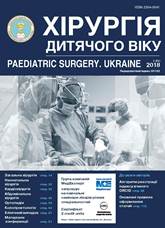Enterostomy in the complex of surgical treatment of newborn with diseases and malformations of the intestine
DOI:
https://doi.org/10.15574/PS.2018.59.81Keywords:
enterostomy, preparation of defunctioned bowel, childrenAbstract
Material and methods. An analysis of the treatment outcomes in 14 ostomy newborns with diseases and malformations of the intestine forms the basis of the paper.Results. Long-term defunctionalisation of the distal segments of intestine leads to their hypotrophy and deep suppression of motor functions resulting in retention of intestinal contents at the level of anastomosis with the risk of suture failure. A new method of preparing the defunctioned bowel and objectification its readiness for reconstructive surgery is proposed. The method provides that in postoperative period the intestinal contents from the proximal segment of the intestine are collected from a child with a loop (double-barrelled) enterostomy. Intestinal contents are inserted into the distal segment through the stoma using a syringe and a probe in portions. The initial volume of intestinal contents, introduced through the stoma, is 1-2 ml, with a gradual its increase to the total volume obtained from the proximal segment of the intestine. Simultaneously retrograde hydrotraining of the defunctioned intestine is carried out with the help of cleansing enemas. Readiness of the defunctioned bowel is evaluated by the natural emergence of faeces after clearing enemas or spontaneous without it.
Conclusions. The use of the suggested method in the preoperative management of ostomy children allows preparing the defunctioned intestine and assesses its readiness for a reconstructive operation taking into account other criteria.
References
Gassan TA. (2003). Preventive intestinal stoomas in children of the period of newborn birth. Moscow.
Ivanov VV, Axelrov MA, Axel'rov VM et al. (2006). Entero-and colostomy in low-grade low-grade intestinal neoplasm in newborns. Pediatric surgery. 6: 14-17.
Muratov ID. (1994). Complications in newborns with intestinal stoma (literature review). Russian herald of perinatology and pediatrics. 39(2): 25-28.
Pashchenko KYu, Pashchenko YuV. (2014). Pat. Ukraine, MPK (2014.01) А61В 17/00. Method of surgical rehabilitation of long-term disabled distal intestinal departments in children. Applicant and patent holder: Kharkiv National Medical University (UA). No. a201308944. Applications on 16.07.2013. Publ. 12.05. Byul. No.9.
Pashchenko YuV., Davidenko VB, Tsiganenko AYa et al. (2006). Preventive intestinal stomach for resection of the intestine under conditions of an infected abdominal cavity in children and the terms of their closure. Kharkiv Surgical School. 1(20): 62-64.
Popov FB, Nemilova TK, Karavaeva SA et al. (2004). Criteria for determining the timing of enterotest closure in newborns and children of the first months of life. Pediatric surgery. 6: 10-13.
Popov FB. (2004). On the technique of enterostomy in newborns. Pediatric surgery. 3: 46-47.
Tsap NA. (1995). Postoperative restoration of intestinal continuity with entero- and colostomas in children: the abstract of the dis. Moscow.
Downloads
Issue
Section
License
The policy of the Journal “PAEDIATRIC SURGERY. UKRAINE” is compatible with the vast majority of funders' of open access and self-archiving policies. The journal provides immediate open access route being convinced that everyone – not only scientists - can benefit from research results, and publishes articles exclusively under open access distribution, with a Creative Commons Attribution-Noncommercial 4.0 international license(СС BY-NC).
Authors transfer the copyright to the Journal “PAEDIATRIC SURGERY.UKRAINE” when the manuscript is accepted for publication. Authors declare that this manuscript has not been published nor is under simultaneous consideration for publication elsewhere. After publication, the articles become freely available on-line to the public.
Readers have the right to use, distribute, and reproduce articles in any medium, provided the articles and the journal are properly cited.
The use of published materials for commercial purposes is strongly prohibited.

